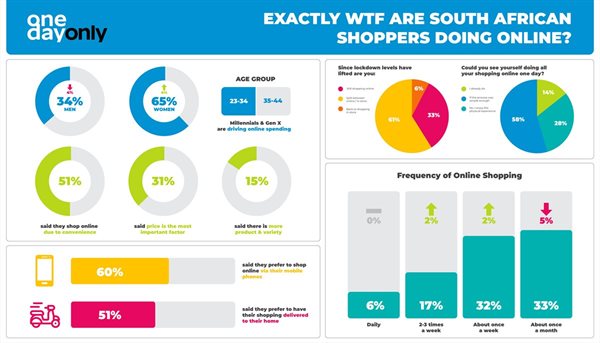
Getty
It was also used to gauge emerging online shopping trends and areas of the online consumer journey the company could address to improve the user experience. The latest survey, had over 9,000 respondents – almost double from last year – and was varied between active online shoppers, infrequent online shoppers and non-shoppers.
The latest ODOmeter update unpacks the numbers to see what has changed over the last two quarters.
Active age brackets
Unpacking the results at a virtual event this week, Laurian Venter, director at OneDayOnly highlighted that the vast majority of online shoppers fall between the ages of 25 and 54.
“The 25 - 34-year-old age bracket is down 4% from the last ODOmeter, while the 35 - 44 and 45 - 54 age brackets are up 2% respectively. Although this may look like the younger age group is shopping less, it is possible that this could be linked to the effects of the long-term lockdown, and an indicator of the 35 - 54-year-old bracket becoming more comfortable with making more frequent purchases online,” said Venter.
Shopping frequency and duration
When looking at the time spent online, more than a third said they spend more than 3 hours a day on the internet. People spending a significant amount of time online – especially with a WFH opportunity for the foreseeable future, coupled with more hours spent at home count in favour of the e-commerce industry.
According to OneDayOnly, it creates an environment where it is easier for the customer to shop using convenience as the catalyst to engagement, whilst allowing the e-tail industry to sell more essential, day-to-day items that consumers would otherwise buy in-store. These ‘supermarket’ trends have been identified globally too with values increasing in the second lockdown compared to the first, towards the end of 2020.
In terms of how often people shop online, the survey indicated that most customers were returning to shop between once a week and once a month, which is up 3% from last year, with nearly two-thirds of the group falling into these brackets.
Security concerns
Also speaking at the event, OneDayOnly’s Jessica van der Westhuyzen, digital and performance marketing manager explained that 50% of the respondents identified security trust as the main detractor from shopping online.
“This shows the importance of continually educating new users on the level of compliance and governance our business undertakes with our secure payment options and why we have the variation of payment platforms available to our customers. It also helps us evolve our FAQs and infotainment strategies that make it easy for our customers to engage with and have conversations with us," said van der Westhuyzen.
Mobile vs desktop, online vs in store
According to dataportal.com, the number of internet users in South Africa has increased by 1.7 million (+4.5%) between 2020 and 2021. Van der Westhuyzen says that interestingly, 60% of people prefer to shop using their mobile phones. This came as a surprise to the team as when asked which platform the respondents preferred shopping from, websites were favoured over apps and while visits are higher on mobile, transactions are taking place on desktop.
“Desktop preference currently sits at 36%, with only 4% of people stating that shopping off a tablet is their preference,” she said.
Last year 68% of respondents had shopped online before the onset of the pandemic, with the consensus of lockdown leading to the marked rise in online shopping behaviour. Now that lockdown levels have lifted, of the 2021 respondents 33% are still primarily shopping online while the majority (61%) are splitting their shopping between online and in store. Only 6% have recommenced shopping predominantly in store. This will also be an interesting trend to keep an eye on in upcoming ODOmeter indices to monitor the shift in future online shopping behaviours.
Top product categories
Product categories that are being shopped for most often are tech at 41%, fashion at 39% and appliances at 32% which make up the top 3 categories. “What surprised us though was that alcohol only drew a 25% response whereas we saw a significant spike in online sales both during and after the booze ban. This indicates potential growth opportunity in online alcohol sales,” said Van der Westhuyzen.
















































